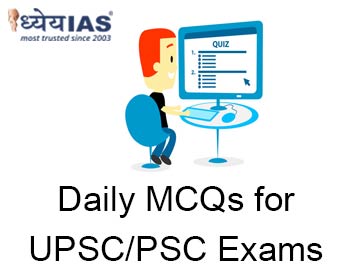Home > Daily-mcqs
Daily-mcqs 12 May 2025

Q1:
Which nodal agency under the Ministry of Commerce and Industry is responsible for CGSS implementation and expansion?
A: NITI Aayog
B: Department of Economic Affairs
C: DPIIT
D: SIDBI
Answer: C
Explanation:
The Department for Promotion of Industry and Internal Trade (DPIIT), under the Ministry of Commerce and Industry, is the nodal body responsible for startup-related policy, including the Credit Guarantee Scheme for Startups. DPIIT plays a key role in aligning the startup ecosystem with national development goals.
Q2:
Consider the following statements regarding the RSF World Press Freedom Index 2025: How many of the above are correct?
A: Only one
B: Only two
C: All three
D: None
Answer: B
Explanation:
Statements 1 and 3 are correct. India, despite improving to 151, is still in the "difficult" category — so Statement 2 is incorrect.
Q3:
Which of the following statements about National Education Policy 2020 is not correct?
A: It mandates implementation of the three-language formula nationwide
B: It promotes instruction in the mother tongue till at least Grade 5
C: It proposes a 5+3+3+4 pedagogical structure
D: It sets a target of 50% Gross Enrolment Ratio in higher education
Answer: A
Explanation:
NEP 2020 recommends (not mandates) a three-language formula, respecting regional autonomy. Mandates would require legislation. Other statements correctly describe its transformative vision—local language instruction, new curricular structure, and expansion of higher education access.
Q4:
Which international organization is supporting the UP AGREES and AI Pragya initiatives?
A: International Monetary Fund
B: World Bank
C: Asian Development Bank
D: UNESCO
Answer: B
Explanation:
Both UP AGREES and AI Pragya are backed by the World Bank, reflecting global support for India’s subnational development programs. The World Bank’s role underscores international recognition of Uttar Pradesh’s potential to become an economic and innovation hub through strategic reforms.
Q5:
With reference to precision-strike capabilities of India’s aerial platforms, consider the following statements: How many of the above statements are correct?
A: Only one
B: Only two
C: All three
D: None
Answer: C
Explanation:
SCALP uses INS, GPS, and terrain reference; HAMMER is terrain-capable and jamming-resistant; METEOR uses ramjet propulsion for constant thrust.
· The HAMMER (Highly Agile and Manoeuvrable Munition Extended Range) is a versatile air-to-ground precision-guided weapon system designed for the Rafale fighter aircraft, with a range of up to 70 km. It is jamming-resistant and can be deployed in medium-range tactical operations.
· The SCALP-EG, a long-range air-launched cruise missile, boasts a 450 km range and advanced navigation for precision strikes.
· The Meteor is a cutting-edge Beyond Visual Range Air-to-Air Missile (BVRAAM) with a solid-fuel ramjet motor, offering the largest 'No Escape Zone' and high effectiveness in electronic-warfare environments. All three systems enhance India's military precision and strike capabilities.